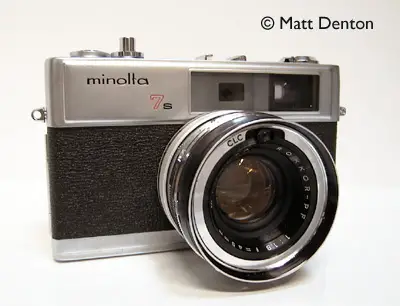- Produced 1966 Minolta Camera Co., Japan
- Film type 135 (35mm)
- Picture size 24mm x 36mm
- Weight 25.6oz (725.8g)
- Lens Rokkor 45mm 1:1.8-22 (6 elements in 5 groups)
- Filter size 55mm screw-in, 57mm slip-on
- Focal range 3′ to infinity
- Shutter Seiko-LA
- Shutter speeds B, 1/4-1/500 manual or automatic
- Viewfinder rangefinder w/ coupled parallax correction
- Exposure meter lens mounted CdS CLC with viewfinder needle (EV)
- EV range 5.7 to 17 @ ASA 100
- ASA 25-800
- Battery originally PX625 1.35v mercury
- Hotshoe, PC sync (syncs at all speeds on X setting)
- SLS film loading system (electronic alignment)
- Self-timer
- Slow-action wind lever (gotcha! see below)
Overview
This camera looks like the Yashica Electro, feels like the Konica Auto S2. In fact, the quirky leather case is the virtually identical to the one on my Auto S2, and if you remove the bottom thumbscrew the cameras fit in each other’s cases. Reminds me of how the Copal shutter & lens housing is almost identical on the Auto S2 and the Canonet QL19 right down to the typeface used for the numbers. Here (as on the Auto S2) the 7s is wonderfully usable entirely in manual mode, with the option to do fully automatic mode (minus focussing of course). The meter is powered by the same EPX13 mercury battery as was in my Auto S2 (equivalent to the PX625, now the 625KA or equivalent Wein Cell).
I somehow managed to get this one for a mere $10US in pretty darn good shape. I was verrrry pleased to find that it works in manual mode as well as automatic, as I’m having a dickens of a time resurrecting a couple of my automatic-only rangefinders. The dials on the barrel are a little too close together for my taste (a common complaint on this type of camera, even with the oft-hyped Canonet QL17), almost as if they weren’t expecting you to shoot in manual mode. But you get used to it quickly, and apart from the wind lever issue (see below) this camera is a pleasure to use. I mentioned the Auto S2 several times for a reason: I think these are comparable cameras, and though I prefer the Auto S2 I think this is a good alternative with nearly the same specs and feel.
One sweet little bonus on this camera (besides actually working in manual mode) is that your aperture/shutter speed selection on the barrel results in an EV number appearing in a little window. So you can judge exposure manually by EV if you know it. (And if you don’t, here’s a primer.) In fact, the needle indicator in the viewfinder reads in EV numbers not shutter speeds. This camera may have the widest aperture range of all these classics – 1.8 to 22.
Repairs
This one needed the rangefinder glass cleaned (cloudy as usual), and new light seals. Also the plastic frame for the eyepiece had come off and needed to be reglued (thanks to the seller for including it!). Another plastic piece on the side is missing altogether, could have been a logo or just a piece of black plastic – I couldn’t tell you. Diamonds are forever, glue and foam not so much. (Cue Shirley Bassey…) I’ll probably replace it with some leatherette someday. Note that on these Minoltas the film door and mating grooves have a pretty tight tolerance, and I’ve had tough luck getting the new light seals to a reasonable thickness and still be able to close the door! Just a heads-up.
Tips & Tricks
Ugh, the longest wind stroke of any of these cameras (with a wind lever, that is!), beating out the previous recordholder the TL Super. Here the stroke goes all the way around to the front! Officially it’s 220°. Egad. Luckily you can (and should) do multiple short strokes — it does thankfully swing smoothly and spring back quickly. Seriously, though, in use this is more minor than I originally thought. You get quickly used to pumping the lever quickly and then don’t even think about it.
As on the Canonet QL19, this is pre- wind-lever-door-release, meaning there is a little tab you pull to get the back door to open, in this case on the left hand side near the top (looking from the back). It’s not obvious. Until you try to lift up the rewind knob, that is, cuz it don’t.
I’ll have to verify this via a manual but it looks like in addition to regular ASA/DIN settings you can switch metering off (to save battery perhaps?) with the same switch on the lens barrel.
Replacements for obsolete batteries such as the once-common PX625 (this one) and PX675, can be got at www.photobattery.com. Not that it’s essential in this case. Your choices are near-equivalent alkaline (eg 1.5v vs 1.35v) or zinc air type and its drawbacks (drilling a small hole in the battery cover to give the battery the air it needs, short battery life). Wein Cell equivalents can be purchased at Micro-Tools.
Related Links
-
- The Minolta Users Group has a Hi-Matic page under ‘body specifications’
- A page of many many Minolta viewfinder & rangefinder cameras
- batteryguys.com – source for hard-to-find photo batteries
